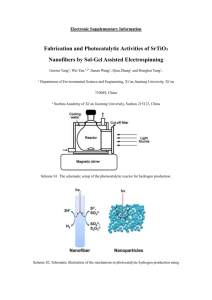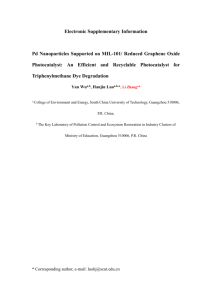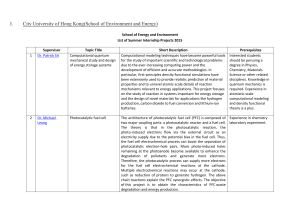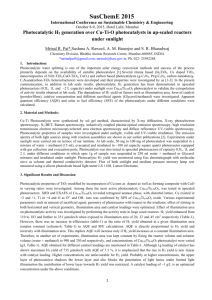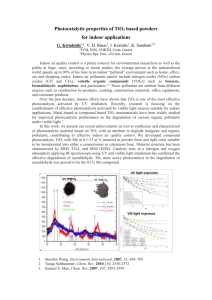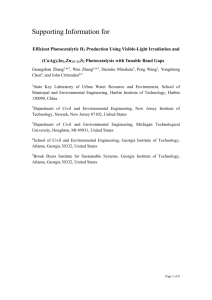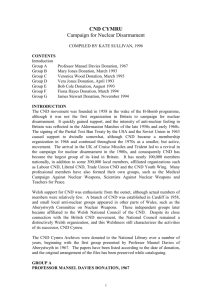150715185218sushmaetalsubmitted
advertisement
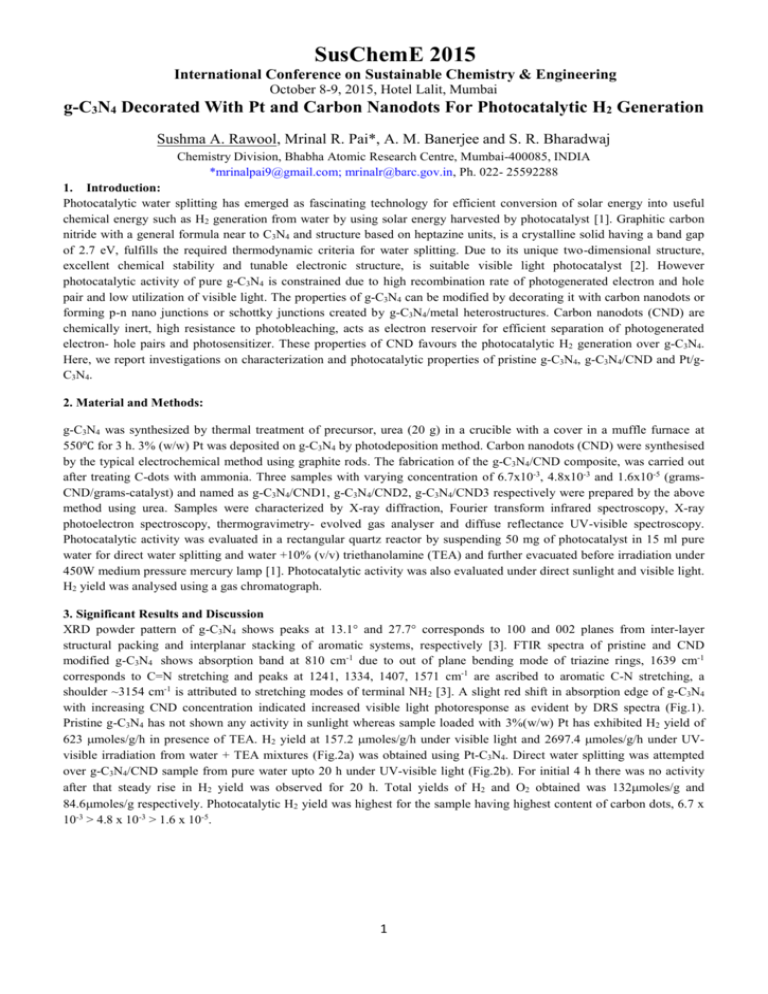
SusChemE 2015 International Conference on Sustainable Chemistry & Engineering October 8-9, 2015, Hotel Lalit, Mumbai g-C3N4 Decorated With Pt and Carbon Nanodots For Photocatalytic H2 Generation Sushma A. Rawool, Mrinal R. Pai*, A. M. Banerjee and S. R. Bharadwaj Chemistry Division, Bhabha Atomic Research Centre, Mumbai-400085, INDIA *mrinalpai9@gmail.com; mrinalr@barc.gov.in, Ph. 022- 25592288 1. Introduction: Photocatalytic water splitting has emerged as fascinating technology for efficient conversion of solar energy into useful chemical energy such as H2 generation from water by using solar energy harvested by photocatalyst [1]. Graphitic carbon nitride with a general formula near to C3N4 and structure based on heptazine units, is a crystalline solid having a band gap of 2.7 eV, fulfills the required thermodynamic criteria for water splitting. Due to its unique two-dimensional structure, excellent chemical stability and tunable electronic structure, is suitable visible light photocatalyst [2]. However photocatalytic activity of pure g-C3N4 is constrained due to high recombination rate of photogenerated electron and hole pair and low utilization of visible light. The properties of g-C3N4 can be modified by decorating it with carbon nanodots or forming p-n nano junctions or schottky junctions created by g-C3N4/metal heterostructures. Carbon nanodots (CND) are chemically inert, high resistance to photobleaching, acts as electron reservoir for efficient separation of photogenerated electron- hole pairs and photosensitizer. These properties of CND favours the photocatalytic H2 generation over g-C3N4. Here, we report investigations on characterization and photocatalytic properties of pristine g-C3N4, g-C3N4/CND and Pt/gC3N4. 2. Material and Methods: g-C3N4 was synthesized by thermal treatment of precursor, urea (20 g) in a crucible with a cover in a muffle furnace at 550℃ for 3 h. 3% (w/w) Pt was deposited on g-C3N4 by photodeposition method. Carbon nanodots (CND) were synthesised by the typical electrochemical method using graphite rods. The fabrication of the g-C3N4/CND composite, was carried out after treating C-dots with ammonia. Three samples with varying concentration of 6.7x10-3, 4.8x10-3 and 1.6x10-5 (gramsCND/grams-catalyst) and named as g-C3N4/CND1, g-C3N4/CND2, g-C3N4/CND3 respectively were prepared by the above method using urea. Samples were characterized by X-ray diffraction, Fourier transform infrared spectroscopy, X-ray photoelectron spectroscopy, thermogravimetry- evolved gas analyser and diffuse reflectance UV-visible spectroscopy. Photocatalytic activity was evaluated in a rectangular quartz reactor by suspending 50 mg of photocatalyst in 15 ml pure water for direct water splitting and water +10% (v/v) triethanolamine (TEA) and further evacuated before irradiation under 450W medium pressure mercury lamp [1]. Photocatalytic activity was also evaluated under direct sunlight and visible light. H2 yield was analysed using a gas chromatograph. 3. Significant Results and Discussion XRD powder pattern of g-C3N4 shows peaks at 13.1° and 27.7° corresponds to 100 and 002 planes from inter-layer structural packing and interplanar stacking of aromatic systems, respectively [3]. FTIR spectra of pristine and CND modified g-C3N4 shows absorption band at 810 cm-1 due to out of plane bending mode of triazine rings, 1639 cm-1 corresponds to C=N stretching and peaks at 1241, 1334, 1407, 1571 cm-1 are ascribed to aromatic C-N stretching, a shoulder ~3154 cm-1 is attributed to stretching modes of terminal NH2 [3]. A slight red shift in absorption edge of g-C3N4 with increasing CND concentration indicated increased visible light photoresponse as evident by DRS spectra (Fig.1). Pristine g-C3N4 has not shown any activity in sunlight whereas sample loaded with 3%(w/w) Pt has exhibited H2 yield of 623 moles/g/h in presence of TEA. H2 yield at 157.2 moles/g/h under visible light and 2697.4 moles/g/h under UVvisible irradiation from water + TEA mixtures (Fig.2a) was obtained using Pt-C3N4. Direct water splitting was attempted over g-C3N4/CND sample from pure water upto 20 h under UV-visible light (Fig.2b). For initial 4 h there was no activity after that steady rise in H2 yield was observed for 20 h. Total yields of H2 and O2 obtained was 132moles/g and 84.6moles/g respectively. Photocatalytic H2 yield was highest for the sample having highest content of carbon dots, 6.7 x 10-3 > 4.8 x 10-3 > 1.6 x 10-5. 1 SusChemE 2015 International Conference on Sustainable Chemistry & Engineering October 8-9, 2015, Hotel Lalit, Mumbai 1.0 g-C3N4 g-C3N4-CND1 g-C3N4-CND2 Absorbance 0.8 0.6 0.4 0.2 0.0 400 500 600 700 800 Wavelength (nm) Figure1: DRS spectrum of g-C3N4 and g-C3N4/CND. 1000 Pt/g-C3N4 UV-visible light 8 g-C3N4/CND1 g-C3N4/CND2 Pt/g-C3N4 sunlight g-C3N4 UV-visible light H2 yield (mol) 800 6 600 4 400 2 200 0 0 0 2 4 a 6 8 0 4 8 b 12 16 20 Irradiation time (h) Figure 2 a) Comparison of photocatalytic activity of Pt/g-C3N4 and pristine g-C3N4 from water + TEA mixtures, b) Effect of CND concentration on H2 yield from pure water under UV-visible irradiation. (Reaction condition: 50 mg photocatalyst in water or water +10% TEA mixture (15 ml), evacuated and irradiated) 4. Conclusions: Pt and carbon nanodots have contributed favourable photocatalytic properties to g-C3N4 as evident by increased photocatalytic H2 yield under sunlight and visible light as compared to pristine sample. Water splitting without sacrificial agent has been achieved over g-C3N4/ CND sample. References: 1. 2. 3. M. R. Pai, J. Majeed, A. M. Banerjee, A. Arya, S. Bhattacharya, R. Rao, S. R. Bharadwaj, J Phys.Chem.C, 116, 2012, 1458; A. M. Banerjee, Mrinal R. Pai, A. Arya, S. R.Bharadwaj, RSC Advances, 5, 2015, 61218. Z. Zhao, Y. Sun, F. Dong, Nanoscale, 7, 2015, 15. B. Peng, S. Zhang, S. Yang, H. Wang, H. Yu, S. Zhang, F. Peng, Materials Research Bulletin, 56, 2014, 19–24. 2


